The Title of the Film
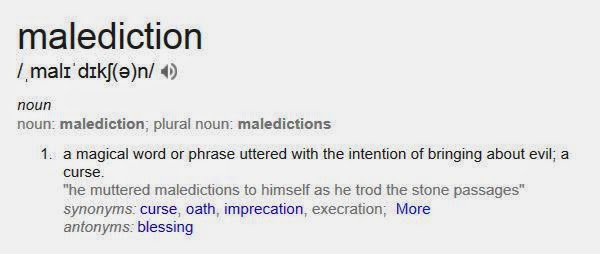 |
| the definition of malediction |
The title of our film, Malediction, can be seen in frame 9 shown on the picture above. This is the final frame in our opening and is white font we produced in LiveType with a simple black background. We thought of the title by looking up the synonyms to words on Google. We came across 'malediction' and none of us knew what it meant. After looking we realised the definition links to our film quite well as it is to do with a 'curse'. It also dawned on us that none of us know what Insidious means so the fact that we have a title that people won't know the meaning of follows the conventions and if anything develops them a bit as it adds another film to the genre that people won't know the definition of.
Setting/Location
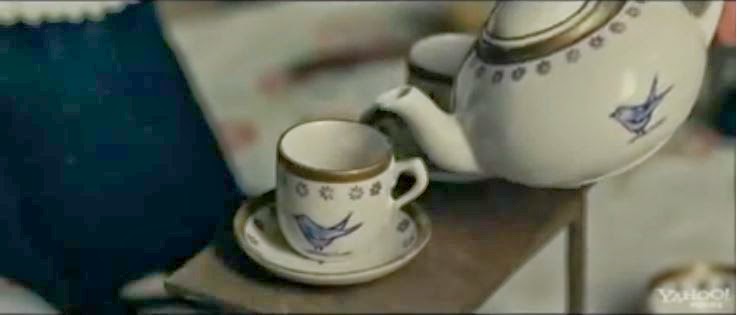 |
| The first shot of The Woman In Black (not an establishing shot) |
Our location is a fairly large house in a rural area. This follows the conventions of supernatural horrors as from my research I found that The Strangers was also set in a house in a rural area. This gives the chance for the protagonist or a stock character to be in an isolated place alone where no one else is near by and typically, as it does in The Strangers, the antagonist(s) appears and harasses them. We have put a stock character, Suzanne in this situation and introduced the antagonist. Having the contrast between the inside shots and outside shots is also something we have done that I believe uses the conventions as typically establishing shots are used at the start of any opening to set the scene. Although, from my previous research I realised that The Woman In Black has no establishing shots in the opening and just goes into close ups and medium close ups in the interior of the house. This makes me think that in some way we could be challenging this element of supernatural horror openings whereas I think for our opening it works better to have establishing shots.
Costumes and Props
We only needed to plan two costumes for our opening, the antagonist's and Suzanne Moor's. In both cases we tried to follow the conventions as best as we can while also making our film individual. Suzanne is an estate agent (she can be seen in frame 4, 6, 7 and 8 in the picture above) so we believed she should be wearing formal clothes (a black dress, black high heels, etc). In retrospect I can see that if anything her costume alone challenges a lot of real media products as generally the stock character will be a regular person in casual clothes as it allows the audience to relate to them. For example in Paranormal Activity the characters wear casual clothes throughout. In this case, for our opening, we have put the regular person in professional clothes which we see may relate to less people but will for people who have jobs.
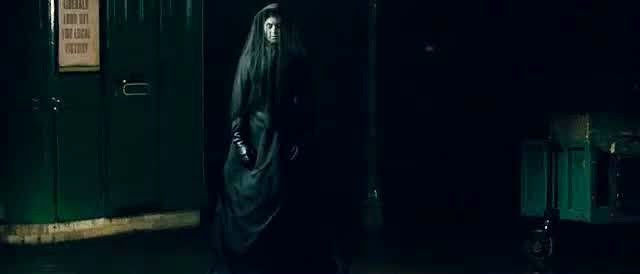 |
| The Woman In Black wearing a traditional dress |
We do, however, think the costume of our antagonist (a white dress, shown in frame 7 and 8) follows the conventions of a supernatural horror as many real media products tend to go for a Victorian twist to make the antagonist seem like a force from the past. This adds a creepy element as the idea of people who are dead now coming back to haunt you can easily freak a lot of people out. An example of a film that uses similar kinds of costume is The Woman In Black as the antagonist wears a black, Victorian style dress throughout.
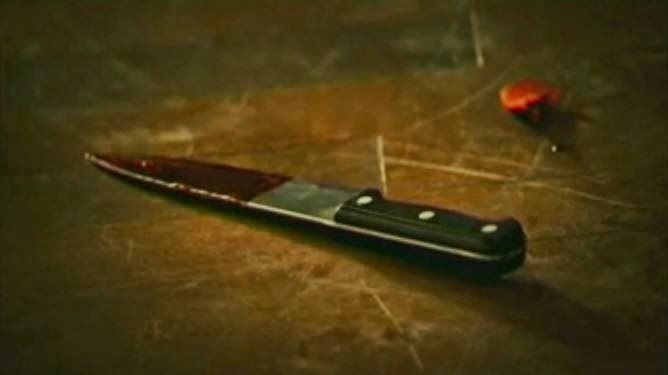 |
| A bloody knife in The Strangers |
The props we used were a doll, a newspaper cut out and a clipboard with estate agent documents on. The doll can be seen in frame 4, 5 and 6 in the picture above. I definitely think the doll follows the codes and conventions as other media products such as The Woman In Black which uses dolls as a very dominant prop throughout. We used the other props to make our product seem more realistic and believable. This is done throughout other openings for example in The Strangers a knife is shown with blood on it and there is blood on the wall which enforces the idea that the media product is real.
Camerawork & Editing
Throughout our opening we have used many shots that are used in real media products. The usual ones like medium shots, close ups and long shots are used. But as well as this the shots we used that I think define supernatural horrors are over-the-shoulder shots (as seen in frame 7 and 8 in the picture above), and shots with slight handheld movement to give the impression that something unknown is in/near the shot. These shots are both used in many film openings such as The Strangers.
Title Font and Style (Typography)
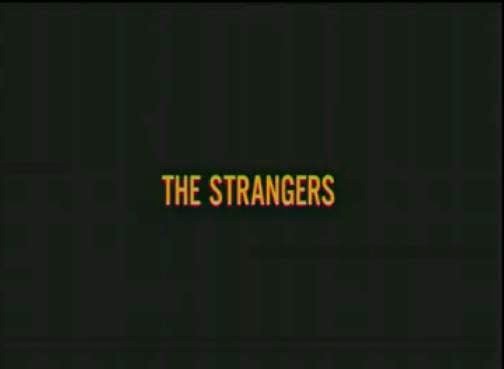
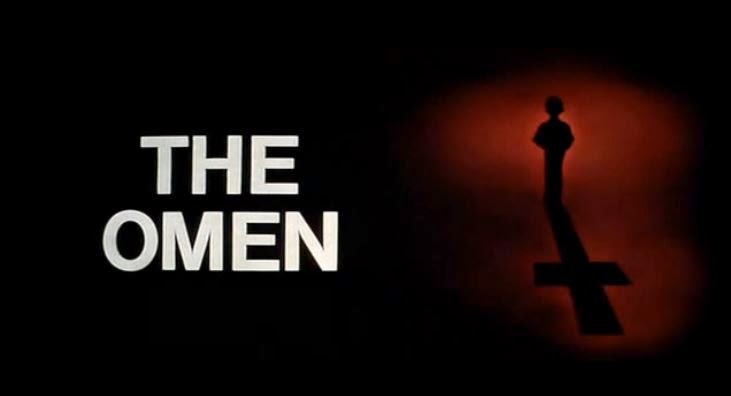
The titles of our film can be seen in frame 1, 2 and 9 shown on the picture above. The text we used is all white font we produced in LiveType. By using a simple font we have used the conventions of real media products as in various openings like The Omen and The Strangers. The Omen uses white simple text on a black background like ours. The Strangers also has simple typography used for its title and it is revealed at the end of the opening by fading in which is very similar to what ours do. I can see why this is a convention in supernatural film openings as it is very effective using the idea of 'less is more' and the fact that a crazy, busy font would distract from the atmosphere of the opening that is created with incidental music.
A conventional film opening uses titles. These usually include the production company, actors names, and who produced and directed the film. These conventions have been followed in our opening however we have slightly subverted it as we have not put in the person who produced it. Although, we do include a production company so I believe this is enough.
Story & How The Opening Sets It Up
Our story is set up in a very conventional way of a lot of supernatural horror movies. We start with writing that fades in and out on a black screen (as shown in frame 1 above) explaining an event in the past and how the causes of death are 'unknown'. This is then followed by shots of the house (exterior and then interior). One shot that particularly sets up our story is the newspaper cutting that's shown that relates to the deaths mentioned at the start. In the same shot estate agent documents are shown which allows the audience to see the house is being sold and possibly infer that someone is investing time looking into the past of the house and trying to sell it regardless of it's past. A stock character is then shown and drawn to a room on the other side of the house as the prop of a doll appeared in the distance. A diegetic laugh leads this character into a room at the end of the house and there she finds the antagonist on the other side of the room who quickly turns towards her and then after a black screen, is very close to her and screams in her face. This gives the chance for the audience to see the antagonist which challenges forms and conventions of supernatural horrors in many ways as usually only a small amount of the antagonist would be shown. For example in The Woman In Black at the end the shoulder of the antagonist is shown which works very well as the audience is more bothered by the unknown. Regardless of that I think it still works well to for our opening to show the antagonist as there is still information the audience may wish to find out about the being including where she is meant to be and why she's there, etc.
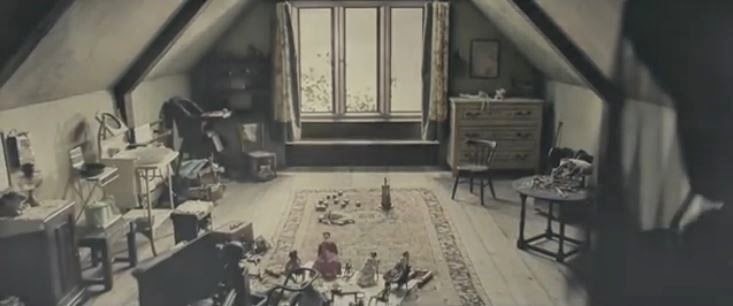 |
| Antagonist subtly shown in the right foreground |
Genre & How The Opening Suggests It
The genre our group chose was a supernatural horror. The opening suggests this greatly with the combination of slow moving shots, incidental music and a stock character which is led into a dangerous situation. An element of this happens in a lot of supernatural horrors that I have seen.
How Characters Are Introduced
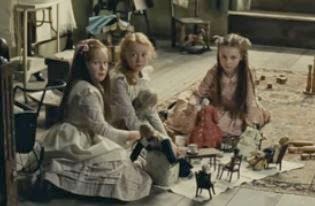 |
| Stock characters in the Woman In Black |
A stock character, Suzanne Moors, is first shown in a medium long shot at 0:46 in the opening. She is shown looking at some props which were just shown. This should allow the audience to realise that she is an estate agent as she is looking over some of her documents. Various medium shots and some close ups are shown of Suzanne throughout the opening which doesn't reveal much about her as a person but lets the audience get acquainted with her and how she looks. This uses the conventions of some supernatural horror openings as in The Woman In Black 3 children who are stock characters are shown but no proper information is given about them which leaves the audience wanting more. The antagonist is introduced with an over-the-shoulder shot (over Suzanne's shoulder) when she walks into the end room. At first we see the antagonist in the background facing away from the character. As she turns towards the camera the shot blacks out leaving the audience wanting more, which they soon get as the antagonist suddenly appears in front of Suzanne's face screaming. This, as I said before challenges conventions of most supernatural horrors as usually the antagonist isn't shown as much as we have shown our antagonist.
Conventionally in any opening the main protagonist or a stock character (or many stock characters) is (are) shown so that the audience is introduced to someone or a situation that is important in the film. For example, from my research I found that the opening of the film Hot Fuzz is entirely dedicated to introducing the protagonist. We have subverted this partially by not introducing the audience to the protagonist. Although, as far as the audience is aware the stock character introduced could easily be mistaken for the protagonist. As well as this as I mentioned before we introduce the antagonist as well who is an important character so we are following the conventions of real media products to have important people in the opening.
Special Effects
No special effects are used in our opening. We do, however use filters (colour correctors) throughout. For the outside shots we put a darker filter with very little saturation while for the shots inside we made brighter/lighter and added a slightly blue filter. From my research I found how slight blue filters were used a lot in openings like in The Woman In Black so I personally believe it was the best choice.
In film openings they will conventionally use some kind of filter to portray a mood. Special effects are used depending on the genre of the film. For example an adventure film will probably use special effects.


 During the preliminary task we all got to grips with the two main editing softwares; Final Cut Express and LiveType. This was very useful as it meant for our opening we would be able to begin editing much faster and with more knowledge of the programme. Although, when we started editing our film opening we did find ourselves learning new skills such as adding filters and changing the speed of clips. We had to balance the roles between each other which was a little more challenging but we all worked well as a group so if someone was controlling the editing then the other two would still have full input. I personally really like editing so for me it was a bit of a downside that the role of editing had to be shared between us but I already had evaluated working alone or in a team and overall a team, if it was in a team with people I got on with (which is was), was a much better decision.
During the preliminary task we all got to grips with the two main editing softwares; Final Cut Express and LiveType. This was very useful as it meant for our opening we would be able to begin editing much faster and with more knowledge of the programme. Although, when we started editing our film opening we did find ourselves learning new skills such as adding filters and changing the speed of clips. We had to balance the roles between each other which was a little more challenging but we all worked well as a group so if someone was controlling the editing then the other two would still have full input. I personally really like editing so for me it was a bit of a downside that the role of editing had to be shared between us but I already had evaluated working alone or in a team and overall a team, if it was in a team with people I got on with (which is was), was a much better decision. 








